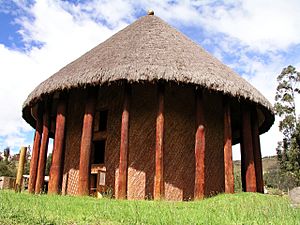Sué facts for kids
Quick facts for kids Sué |
|
|---|---|
| Sun | |
| Member of Muisca religion | |

Sué setting behind Bacatá
|
|
| Other names | Xué, Sua, Zuhe, Suhé |
| Affiliation | Chiminigagua (light) Cuchavira (rainbow) Chibchacum (rain) |
| Major cult center | Sun Temple, Sugamuxi |
| Day | Summer solstice |
| Region | Altiplano Cundiboyacense |
| Ethnic group | Muisca |
| Consort | Chía (Moon) |
| Greek equivalent | Helios |
| Roman equivalent | Sol |
| Norse equivalent | Sól |
| Etruscan equivalent | Usil |
| Slavic equivalent | Dazhbog |
| Hinduism equivalent | Surya |
Sué (also called Xué, Sua, Zuhe, or Suhé) was the important god of the Sun for the Muisca people. He was married to Chía, the goddess of the Moon.
The Muisca were an advanced civilization in the Americas. They lived in the Andes mountains, in a high plateau called the Altiplano Cundiboyacense. Their beliefs and way of life were very connected to nature. Both the Sun (Sué) and rain (controlled by Chibchacum) were super important for their farming.
The Sun God Sué
The Muisca believed that the god Chiminigagua created light and the world. After that, he created Chía and Sué. They were made to be the Moon and the Sun.
A Spanish explorer named Gonzalo Jiménez de Quesada wrote about the Muisca. He said they saw the Sun and Moon as the parents of everything. They believed Sué and Chía were like a husband and wife.
Sué's Influence and Worship
Chía, the Moon goddess, was linked to the zipas. These were the rulers of the southern Muisca lands. Sué, the Sun god, was linked to the zaques. They ruled the northern Muisca areas. The leader, or cacique, of Ramiriquí was also connected to Sué.
Sué was mainly worshipped at the Temple of the Sun. This temple was in a place called Sugamuxi, now known as Sogamoso. Today, Sogamoso is sometimes called the "City of the Sun." There were also temples for Sué in Bacatá and Guatavita. Sadly, the original Sun Temple in Sogamoso was burned down by the Spanish conquerors.
Celebrations for Sué
On the day of the summer solstice, which is the longest day of the year, Muisca nobles held special events. They walked in a procession to the temples. There, they made sacrifices to ask Sué for good harvests.
The people celebrated this day with big parties. They painted their bodies and drank chicha. Chicha is a traditional corn drink. They also honored their own shadows. They believed that Sué gave them a personal god that stayed with them all day.
See also
 In Spanish: Sué para niños
In Spanish: Sué para niños


